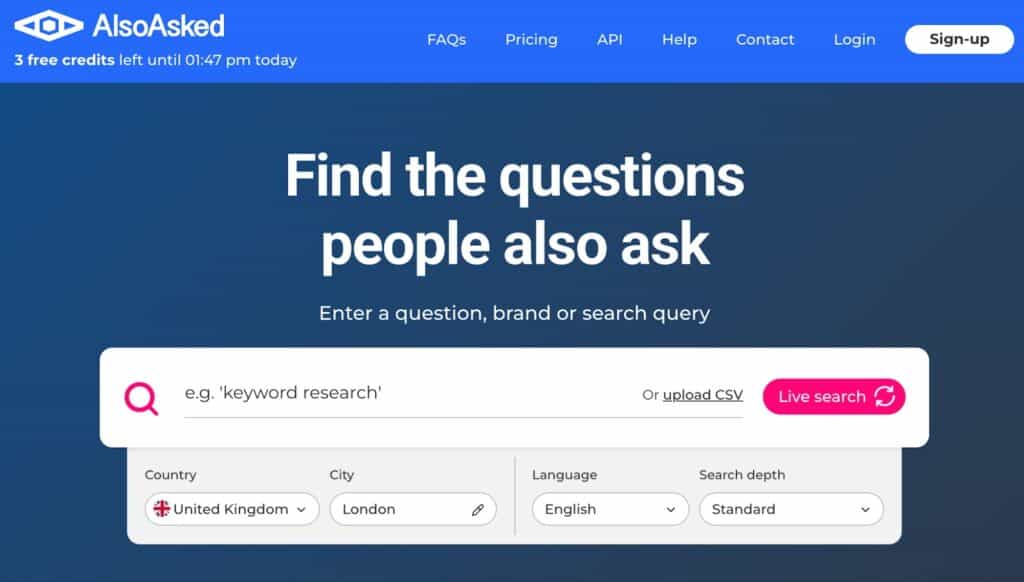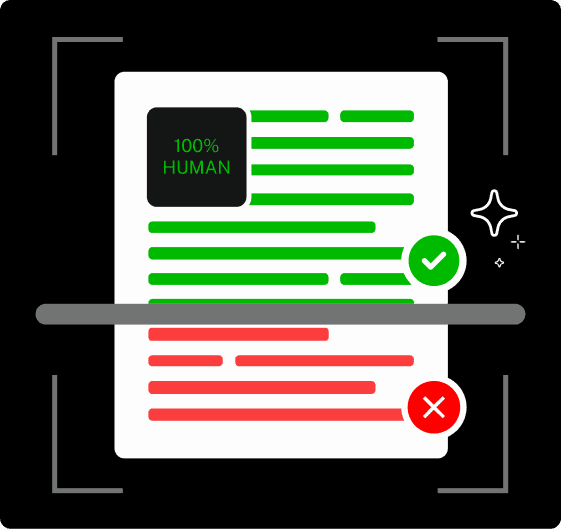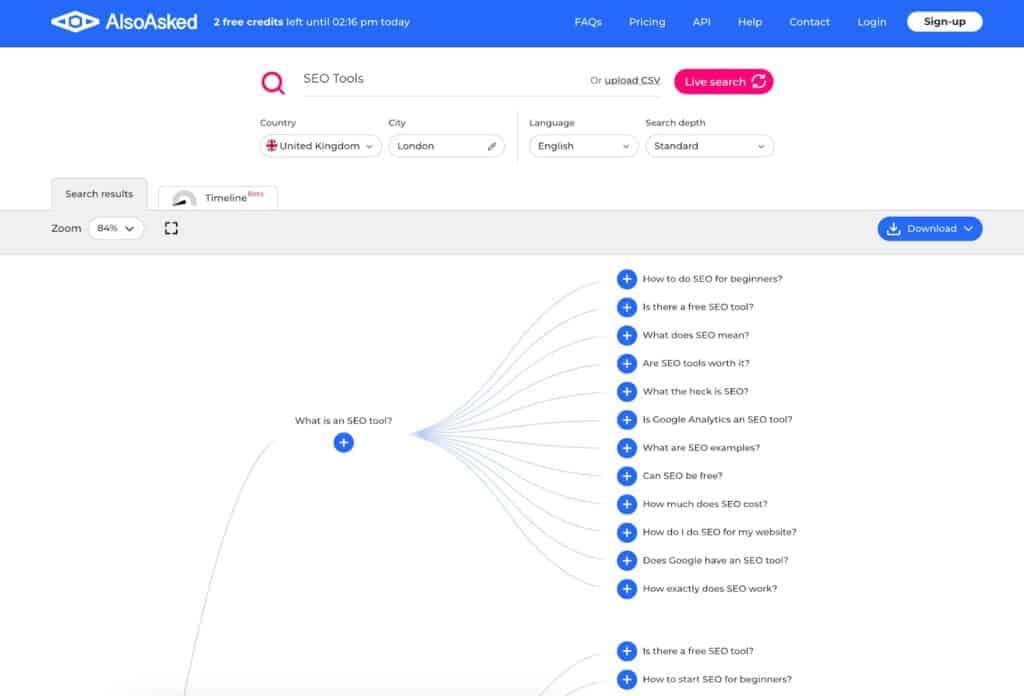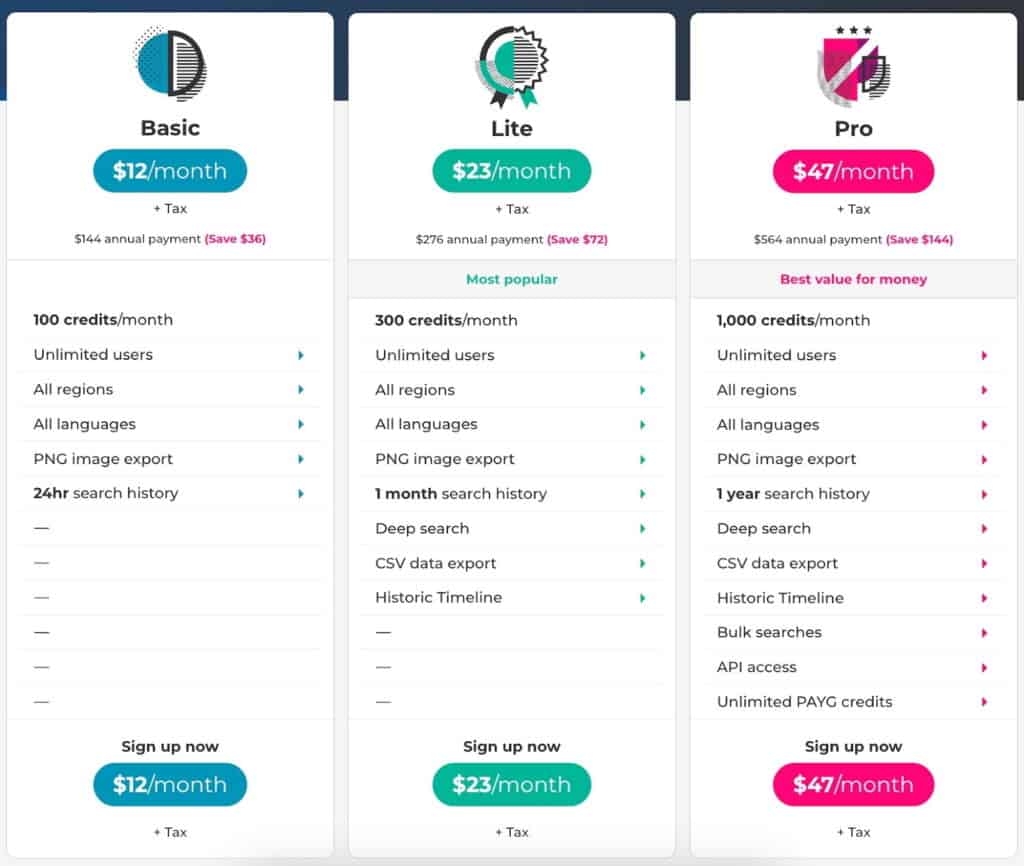AlsoAsked is a keyword research and content ideation tool that visualizes how real users ask questions on Google, using data from the “People Also Ask” feature.
It was founded in 2019 by digital strategist Mark Williams-Cook, who wanted to help marketers better understand search intent and structure content around actual user journeys.
Unlike many keyword tools, AlsoAsked doesn’t go heavy on search volume or CPC data. It only gives you a pretty good set of questions grouped by similar purposes of search.
I put AlsoAsked to the test across a few live projects because I was curious about how practical it really is. And in this AlsoAsked review, I talk about what I learned after using it.
What Is AlsoAsked?

[Alt text: Image showing AlsoAsked homepage. Source.]
AlsoAsked is built around one simple source, Google’s “People Also Ask” (PAA) data.
Anytime you search for something on Google, there is an expandable list of follow-up questions. That is Google’s People Also Ask section.


Never Worry About AI Detecting Your Texts Again. Undetectable AI Can Help You:
- Make your AI assisted writing appear human-like.
- Bypass all major AI detection tools with just one click.
- Use AI safely and confidently in school and work.
To understand similar user intent for a keyword based on the PAA section, you have to open and copy those questions one by one.
AlsoAsked tool maps out all those related questions in a clear, visual tree structure for you.
What’s better is that the tool groups all the questions logically into layers.
It turns scattered, nested PAA questions into structured maps that show how user questions connect.
How AlsoAsked Works
When you enter a broad keyword or phrase in AlsoAsked, it goes straight to Google’s PAA section and interacts with these boxes automatically, like what a real user would do by expanding each question to trigger more related ones.
Once the questions are collected, AlsoAsked organizes them into a visual hierarchy.
At the extreme right of the tree is your original keyword. To the left of that are the primary related questions that show up first in Google.
Click on any of those primary questions, and AlsoAsked shows you what questions people ask after that, which makes a second layer.

[Alt text: Image showing AlsoAsked questions in hierarchy based on original query.]
Some queries even go three or four layers deep, exactly how a casual browser moves through a topic in real time.
AlsoAsked also lets you customize both language and location settings. It’s not restricted to English or the U.S., you can run your searches in any language and region.
It is a brilliant keyword clustering tool. You can see how questions branch out from a main topic and structure your content accordingly, i.e., a central pillar page for the core keyword, and supporting blog posts for each sub-question.
Features Overview
AlsoAsked is packed with features that make it genuinely useful for SEOs, content strategists, UX researchers, and marketers.
Besides its core function of generating keyword cluster maps, here are some features that I particularly like:
- PNG export: After running a query, you can export the entire question map as a PNG image. This is great if you’re building a content strategy, pitching to clients, or just want a quick way to communicate how questions connect around a topic.
- CSV exports: If you’re someone who likes working in spreadsheets, you can export all the data from a search in CSV format. And it includes the full list of questions, the answer snippet Google shows in the PAA box, the URL of the page Google is pulling that answer from, and the page title of that source.
- Deep search: AlsoAsked surfaces around 150 real, user-generated questions per query on average, way more than you’d find by manually Googling.
- Bulk Search: You can upload up to 1,000 keywords in a single CSV, hit go, and AlsoAsked returns a tidy ZIP file containing all your results with each query neatly exported with its question set, Google snippet, ranking URL, and more.
- API access: AlsoAsked gives you API access with both sync and async modes. You can integrate live PAA data into your internal platforms, content ops tools, dashboards, or client reporting systems to automate topic research.
- Search history: Your AlsoAsked dashboard keeps a full search history so you can re-download old results (without burning more credits) or track how a topic’s PAA data has changed over time.
And to actually execute on AlsoAsked keyword research strategy and turn those questions into high-quality, natural, human-like content that ranks, you need Undetectable AI’s AI SEO Writer.
Combine that with an AI Humanizer, and you’ve got content that answers search queries and sounds authentic and editorially sound.
Free vs. Paid Plans

[Alt text: Image showing AlsoAsked pricing plans.]
AlsoAsked allows you to run 3 free searches per day. You don’t need to sign up or enter your credit card details to use your free credits.
Although 3 searches a day is pretty limited, it is great if you just want to try the tool or do occasional topic research.
AlsoAsked pricing is divided into 3 tiers.
The basic plan is priced at $12/month (+ tax), and it gives you:
- 100 credits/month (1 credit = 1 search)
- Unlimited users
- Access to all regions and languages
- PNG exports for those visual question maps
- 24-hour search history (i.e., cached searches stay for one day)
The Lite Plan is a tier up at $23/month (+ tax), where you get:
- 300 credits/month
- Unlimited users
- Full access to all regions and languages
- PNG + CSV exports to get raw data
- 1-month search history
- Deep search mode
- Historic timeline (lets you see how search interest and question phrasing change over time)
Finally, there’s a Pro Plan for those working at scale, priced at $47/month (+ tax), and it brings:
- 1,000 credits/month
- Unlimited users
- Everything from Lite (PNG, CSV, Deep Search, Historic Timeline)
- 1-year search history
- Bulk Search support (upload up to 1,000 queries at once)
- API access (integrate AlsoAsked into your own tools or dashboards)
- Unlimited PAYG credits (i.e, buy more on top as needed)
AlsoAsked in Real-World Use
The core value of AlsoAsked lies in how it visualizes search intent through real user questions.
Now, those questions are used by businesses in different ways.
- Defining Content Hierarchies Based on Intent Flow
One of the biggest challenges in content strategy is knowing what to cover and in what order. AlsoAsked maps questions people have searched on Google into intent-based hierarchies.
These visual maps are great to see the questions people are interested in knowing the answers of around any topic and how their curiosity progresses from one question to another.
You can structure your content to mirror exactly how users think based on the data you get.
Make the top-level query your pillar page and the follow-up questions your natural subtopics to cover the full scope of a keyword.
- Semantic Research for Programmatic SEO
It is an amazing tool for businesses working on programmatic SEO (like travel, eCommerce, or SaaS directories) that have to expand their semantic coverage at scale.
You can extract the relevant PAA questions for hundreds or thousands of keywords using bulk search feature, all at once.
- Validating What to Include in Content Briefs
AlsoAsked gives you a filtered list of actual questions people have searched on Google. That’s essentially what blog posts try to cover.
Use the questions pulled by AlsoAsked to validate what subheadings are worth covering in your post and, equally important, what can be left out.
It prevents your time and effort from being wasted on answering things no one searches for.
Instead, every question included in a brief is backed by real-world search behavior.
- Identifying Content Gaps
AlsoAsked helps SEO teams spot content gaps and blind spots in published content.
Run your main keywords through the tool and see which follow-up questions you failed to address previously.
From there, you can update content briefs and optimize existing pages.
Or, if there’s a lot of new content to cover, you could split it off and make new posts that go deep into specific subtopics.
Pros and Cons

AlsoAsked is not an all-in-one SEO platform. It has a very focused use case to help you explore and extract value from People Also Ask data.
Naturally, it has its pros and cons.
Pros
Here are some reasons why AlsoAsked is a great keyword research tool:
- Visually maps out question clusters
- Organizes questions by relationships so you can build topic clusters and pillar pages with flow
- Supports all major languages and regions
- AlsoAsked API access is great for automation
Cons
AlsoAsked has some trade-offs, too. It doesn’t give you everything you’d expect from a full-fledged keyword research suite.
Some features I found missing include:
- No search volume, CPC, or keyword difficulty metrics
- No content creation or optimization tools
- Credit-based pricing model is limiting to some users
AlsoAsked vs. Competitors
AnswerThePublic and KeywordsPeopleUse are two of the competitors of AlsoAsked that work based on user search data through Google.
AnswerThePublic scrapes autocomplete data from Google and organizes it into visual clusters. The clusters include questions, prepositions, and comparisons based on a keyword.
What makes AnswerThePublic particularly great is that it also gives you basic search metrics like volume and CPC for each phrase.
So you can do some light keyword validation within the tool.
AlsoAsked, by contrast, pulls its data directly from Google’s “People Also Ask” boxes and maps out the relationship between questions, which isn’t obvious in AnswerThePublic’s clusters.
KeywordsPeopleUse shares some DNA with AlsoAsked, such that it also pulls data from the “People Also Ask” section, but its search results add Quora threads and Reddit questions too.
It is super handy if you’re looking to gather ideas from different corners of the internet.
Like AlsoAsked, the KeywordsPeopleUse tool organizes results in a tree-like structure. Both tools lack the metrics data for the search queries they bring up.
Who Should Use AlsoAsked?
AlsoAsked is built for people who need to understand how people actually think and search online.
It is very helpful for in-house content teams/bloggers who want to write their posts based on real questions.
AlsoAsked is also a great resource for professionals in product marketing and UX roles.
It supports better decision-making around copywriting because you can address the questions people have about your product through blogs or FAQs.
Explore our AI Detector and Humanizer effortlessly in the widget below!
Final Verdict
AlsoAsked is a great tool to understand the user search intent around a keyword, but it is not a full-scale SEO solution.
You will have to export that data into another tool that gives you keyword metrics to make full use of these keywords.
Once you’ve shortlisted your high-value keywords, Undetectable AI’s AI SEO Writer fits into your workflow for content creation.
Just answer a few quick questions about your target keyword and audience, pick a title from AI-generated options, and set your desired word count.
You’ll get an SEO-optimized article complete with custom images and outbound links to credible sources in seconds.
Try Undetectable AI now.
